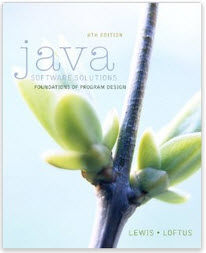Object Based Programming
Java Software Solutions, 8th Ed., by John Lewis and William Loftus, Published by Pearson Pub. ISBN: 10: 0133594955 / 13: 9780133594959
VideoNotes, Source Code, Lab Manual and Java Development Environments available at Companion Site.
This is an introductory course in problem solving using JAVA to demonstrate the primary concepts. Participants write computer programs to solve real-world problems using precise logic, developing complete specifications, communicating intent, and paying excruciating attention to details which will make learning JAVA programming easier.
Objectives
- Identify and describe the role of essential archittectureal components of a computer system.
- Identify and describe the rolw of representation of multimedia data in the computer.
- Identify and describe how components of the computer collaborate to execute instructions.
- Identify and describe the basics of computer networking.
- Strengthen critical skills including general problem solving and logical thinking through the use of computer tools.
Approach
The class will be in hybrid format. Lecture materials, assignments, are available on our Moodle course site (Note: Please use the Moodle Messages to communicate with the instructor directly and the course discussion forum to communicate with your class mates). It is expected that you will do a large amount of independent learning. The required computing platforms and programming environments are available for download and in the ITEC labs in DB.
Basic Web publishing: HTML concepts and coding techniques will be applied to producing assignments uploaded/published as Web page presentations on the York student Web server.
Grades Breakdown:
- Assignments 15% (5 @3% each)
- Midterm Examination 30% (In-class)
- Final Examination 55% (Exam Period)
Topics Covered:
- Introduction (Chapter 1)
- Data and Expressions (Chapter 2)
- Using Classes and Objects (Chapter 3)
- Writing Classes (Chapter 4)
- Conditionals and Loops (Chapter 5, 6)
- Object-Oriented Design (Chapter 7)
- Arrays (Chapter 8)
